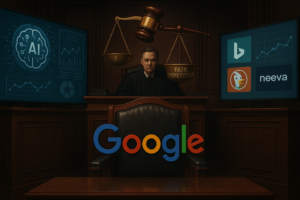Revolutionizing Education: How AI is Driving Pearson’s Growth
In an era where artificial intelligence (AI) is reshaping industries, Pearson, a leading educational publisher, is riding the wave of innovation to generate impressive sales growth. The company recently reported a 4% increase in underlying revenues for the third quarter of 2024, reflecting its strategic investments in AI technologies. This remarkable performance is not just a financial victory but a testament to the potential of AI to transform the educational landscape.
CEO Omar Abbosh emphasized the company’s commitment to enhancing its AI capabilities across various business sectors. By integrating AI into its educational offerings, Pearson is not merely keeping pace with industry trends but is actively setting them. The company reported that there were over 5 million student interactions with its AI study tools, highlighting how AI is becoming an integral part of the learning experience.
Resurgence in Higher Education
Pearson has also seen a resurgence in its higher education division, which had previously faced stagnant sales. The third quarter brought a 4% uptick in revenues, signaling a rebound attributed to the adoption of AI-driven solutions in virtual learning environments. With rising enrollment numbers, Pearson’s virtual schools have successfully integrated AI applications, providing personalized learning pathways and step-by-step assistance to students struggling with difficult subjects.
Innovative Initiatives
One innovative initiative is the introduction of the Teaching Pal, an AI-enhanced tool designed to create customized lesson content and activities. This tool aims to cater to the diverse needs of learners, ensuring that every student receives the support they need to thrive academically. By infusing AI into its educational resources, Pearson is not just enhancing engagement but is also promoting higher retention rates and improved learning outcomes.
Moreover, the company has launched a Generative AI Foundations certification, which equips individuals with the skills necessary to navigate and leverage generative AI technologies. This move is indicative of Pearson’s forward-thinking approach, as it prepares students for the demands of a workforce increasingly reliant on AI competencies. By bridging the gap between education and industry needs, Pearson is positioning itself as a vital player in the future of work.
Market Analysis and Future Outlook
Market analysts have noted Pearson’s shift away from outdated business models, with some suggesting that the company’s proactive strategies could redefine educational publishing. As Pearson continues to accelerate its AI investments, the challenge will lie in maintaining this growth trajectory. The company’s ability to adapt and innovate in a rapidly changing environment will be critical to its ongoing success.
Looking ahead, Pearson is optimistic about meeting its annual forecasts, projecting adjusted operating profits around £598 million. With a clear vision for the future, bolstered by AI advancements, Pearson is not only enhancing its educational offerings but also reshaping the way education is delivered and experienced.
In conclusion, Pearson’s recent successes illustrate the transformative power of AI in education. As the landscape continues to evolve, companies willing to embrace innovation and adapt to the needs of learners will undoubtedly lead the charge in redefining educational excellence.


